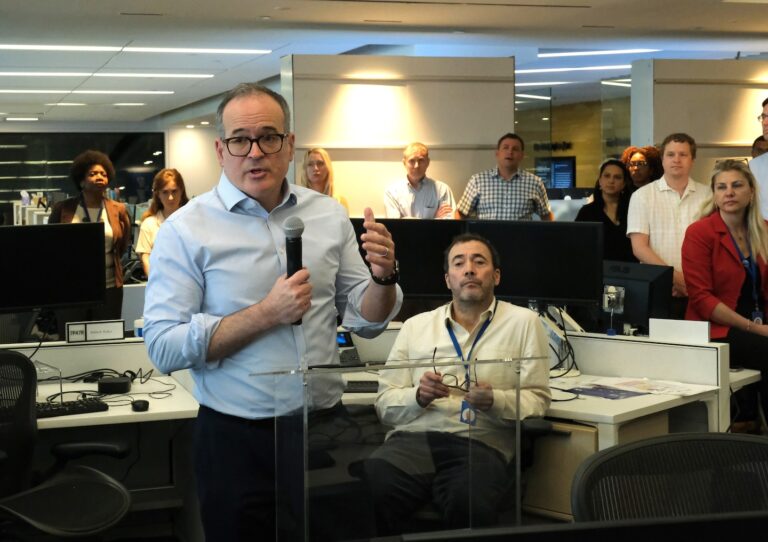Lewis, who previously worked with Murray at The Wall Street Journal, called him “a real journalist who likes to get into trouble and to work with fellow editors and reporters, and an old-fashioned editor who edits every day.”
But Lewis did not answer specific questions about Buzbee’s decision to step down, which surprised staff, when he announced his departure in an email Sunday night.
“Sally was a real pleasure to work with,” Lewis said, praising her. “I wish we could have gone on for longer, but we couldn’t, and I don’t think it’s appropriate to continue that part of the conversation any further.”
He also apologized for the way he made the announcement: “The news started to leak out, and we had to panic.”
Buzbee, the first woman to lead The Washington Post’s news division, did not respond to a request for comment.
As recently as last weekend, she hadn’t signaled any intention to resign: On Saturday night, she attended the White House Press Photographers Association awards dinner, mingling with reporters from The Washington Post and sitting next to White House press secretary Karine Jean-Pierre.
In a brief call late Sunday with division heads at the Post, she said she was presented with a restructuring plan that she wanted no part of, according to three people familiar with the matter, who asked not to be identified because they were not authorized to speak.
But Lewis had been reaching out to potential replacements for Buzbee for weeks before announcing his departure, according to a person familiar with the conversations who spoke on condition of anonymity.
Buzbee did not attend Monday’s staff meeting, but drew thunderous applause from Post colleagues who questioned her treatment by company executives.
Murray will be relieved of his role as editor-in-chief of The Wall Street Journal after nearly five years in early 2023 but will remain in an advisory role at parent company News Corp. He had been in negotiations for other job opportunities but decided to accept Lewis’ offer to join The Washington Post after a lengthy search, one of the people said.
In his remarks, Murray, who spent 29 years at The Wall Street Journal, said he was focused on a future that blends The Post’s traditions with a forward-thinking approach to news.
Murray, a Washington, D.C., native, said he has no plans to remake The Washington Post in the image of The Wall Street Journal, which he cited as the newspaper that inspired him to want to pursue a career in journalism.
“I’ve been in this industry long enough and done enough that I’m not interested in managing the decline at this point,” Murray said. “I’m interested in the future and growth. … This is going to be an exciting time. There’s going to be a lot of new opportunities and new things happening for us.”
Murray is only replacing Busby on a temporary basis, Lewis announced on Sunday. After Election Day, he will hand over control of the newsroom’s key reporting areas – politics, investigative, business, technology, sports and features – to Robert Winnett, the British journalist currently deputy editor of Telegraph Media Group.
At that point, Murray will take over as head of a new division of the company that Lewis outlined on Sunday, focusing on service and social media journalism.
Mr Lewis had previously worked with both Mr Murray and Mr Winnett, the former when Mr Lewis was publisher of the Journal and the latter when Mr Lewis was editor of the Daily Telegraph.
During Monday’s meeting, a staff member highlighted those connections, as well as Lewis’ past comments about diversity efforts.
“In the most cynical interpretation, you picked two guys to help run The Washington Post,” she says, “and now you have four white guys running three newsrooms.”
Lewis called the new division overseen by Murray a “third newsroom,” distinguishing it from the news division led by Winnett and the Post’s opinion division, which will continue to be overseen by David Shipley.
Lewis also reaffirmed his commitment to diversity while acknowledging the realities for new hires, saying, “I have to work harder. You’ll see that in the future.”
Murray did not discuss specific editorial priorities in his brief remarks, but he did list several specific stories that would be top priorities for The Post, including the presidential election and the trials facing Donald Trump and Hunter Biden.
“The Washington Post has a great legacy, a history and tradition of great journalism, from the past to this morning,” he said. “So many great stories have come out of this newsroom, and I’m honored and proud to be a part of it.”
The decision to change editorial leadership and create new divisions is part of Lewis’ new strategy for The Post, focused on reaching new readership and rejecting a “one-size-fits-all” strategy to serve readers and attract new customers.
But Murray said he has no plans to blow things up just to get there. Going forward, Murray said The Post’s mission is “to pivot in what we’re doing.”

